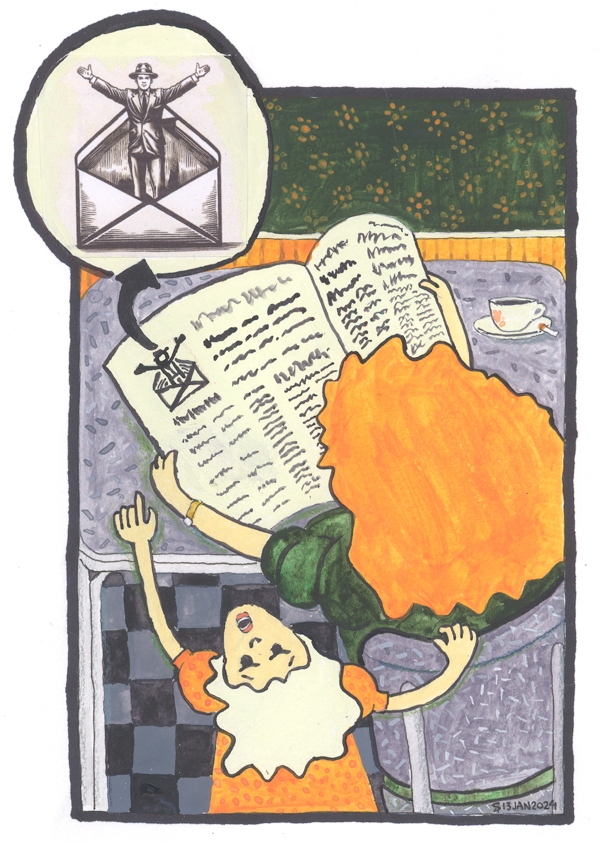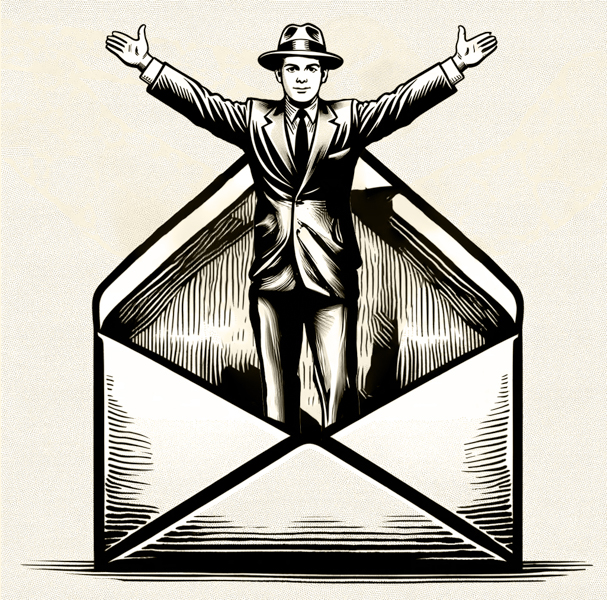Mad in Pursuit Notebook
Envelope Man: Pocket Friend Who Wasn't
A memory of first longing

I've been thinking about the intersection between memory and imagination. In the early fifties, an era full of puppets and fairies, I identified my own pocket companion... just out of reach.
 It was in our apartment on Penrose. No idea how old I was, but I was tall enough to look over Mom's shoulder while she read the evening paper at the kitchen table. Let's say it was mid-1950s.
It was in our apartment on Penrose. No idea how old I was, but I was tall enough to look over Mom's shoulder while she read the evening paper at the kitchen table. Let's say it was mid-1950s.
She must have been reading letters to the editor. I spotted a logo—the kind of drop-in graphic newspapers use to mark a regular section. The black line art, which had to be less than two inches square, depicted a man in a business suit sort of springing out of an envelope. (The image below is an AI attempt to re-create the graphic, which I can't find in any archive.)

I wanted him.
I was seized by longing. A man tiny enough to fit into an envelope... a coat pocket... a purse? All mine? Yes!
I'm trying to think what stunned me about this guy. Why has his image been seared into my memory for seventy years? Why was having a pocket friend such a wonderful and enduring idea?
I was a shy child, but not a lonely one. I had a little brother Tom. My cousin Bobby lived in the apartment upstairs. In fact, at the height of the post-war baby boom, our St. Louis neighborhood was swarming with kids in every direction.
What were the influences that made me think having a pocket friend would be a grand idea?
Pop culture
The early 1950s brought a TV bonanza to the Boomer kids. Commercial television became a thing around 1947, but TVs took a while to plant themselves in every home. I think we got ours soon after Tom was born. Let's say 1952.
What was on?
Puppets. Howdy Doody—marionettes plus humans. Kukla, Fran, and Ollie—hand puppets plus human. Paul Winchell and Jerry Mahoney—ventriloquist plus his pair of dummies. Even Ding Dong School had puppets: Lucky the rabbit and Jocko the monkey. In fact, at some point in there, I had my own Lucky and Jocko hand puppets. I remember Kitty Mom trying to teach me to "throw my voice," but I didn't get it.
Tinker Bell. Disney released its animated film Peter Pan in February 1953. I was four.
Then in March 1955, we gathered around the TV at Kitty Mom's to watch the live musical stage production with Mary Martin and Cyril Ritchard. I was fascinated by Tinker Bell as a bouncing light and by the strings that made Mary Martin fly.
Jiminy Cricket. Walt Disney's Pinocchio was made in 1940. Disney's policy was to withdraw its movies from the public, then have a big theatrical re-release every few years. In my day, it was 1954, the year I turned six. Did I fancy the conscientious mentor cricket as a pocket companion?
An aside about saints and angels. Growing up Catholic gave me a whole pantheon of supernatural beings to keep me company. I was aware that I had access to the help of a guardian angel, but she was never very real to me. We had one religious statue in the apartment: the Infant Jesus of Prague. It sat high on a window sill, draped with the beaded hospital i.d. bracelets of Tom and me, for our protection. It was my mom's thing.
1955 (when I was going on seven) saw the introduction of plastic Jesus figurines, for automobile dashboards [1]. Great size for a pocket companion, right?
My point is that the era was rich with congenial non-human companions—puppets, dummies, fairies, dashboard saviors, and the chatty grasshopper.
I was a child of the early-fifties pop culture, primed for a new character—my own secret character.
And there he was.
Over my mother's shoulder, hidden within the editorial pages of the newspaper, Envelope Man caught my eye. The image was unexpected. It surprised and delighted me—a silent thunderbolt setting my imagination on fire and triggering my sense of longing.
I was a rational child. I knew the mechanics of puppetry. I knew that statues were symbols. Fairy tales and ghost stories were make-believe, meant to entertain me, not to scare me.
But, in an instant, I understood what it meant to desire someone who overpowered my imagination, yet was out of reach.
I was charmed.
Notes
[1] "Jesus figurines for the dashboard were first introduced by the Sacred Heart Auto League [based at Sacred Heart Southern Missions of Walls, Mississippi]. This league was founded by Father Gregory Bezy... in 1955, as the United States became increasingly aware of the dangers associated with automobiles. Hoping to encourage drivers to be more mindful on the road, the Sacred Heart Auto League began to distribute small statuettes of the Sacred Heart of Jesus to be affixed to their dashboards." The History of 3 Classic Car Decorations from the 1950s
FOLLOW me on my Facebook page, share this post to your friends, and....
Books from Mad in Pursuit and Susan Barrett Price: KITTY'S PEOPLE: the Irish Family Saga about the Rise of a Generous Woman (2022)| HEADLONG: Over the Edge in Pakistan and China (2018) | THE SUDDEN SILENCE: A Tale of Suspense and Found Treasure (2015) | TRIBE OF THE BREAKAWAY BEADS: Book of Exits and Fresh Starts (2011) | PASSION AND PERIL ON THE SILK ROAD: A Thriller in Pakistan and China (2008). Available at Amazon.